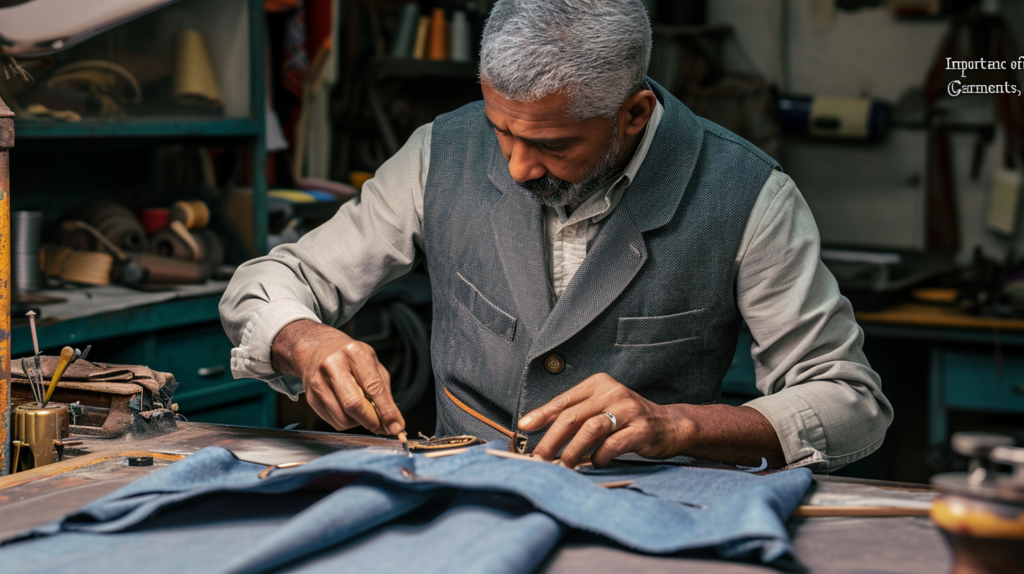
The Importance of Quality Garments
The idea of ‘buy less, buy better’ resonates deeply within sustainable tailoring. Tailors are dedicated to crafting timeless, durable pieces, steering customers away from the transient allure of fast fashion. This commitment to quality over quantity significantly diminishes the overall consumption and waste prevalent in the fashion industry. The ability to re-tailor suits means that even if your favorite suit no longer fits, you can return to your favorite tailor to get it refitted to your body. This prevents you from getting rid of custom clothing before it’s worn out. Custom tailoring, emphasizing individual demand rather than mass market trends, inherently reduces overproduction, thereby addressing a primary source of fashion industry waste and its contribution to overflowing landfills.
Removing Long Distance Transportation
Local custom tailoring significantly reduces the environmental impact of garment production by emphasizing local sourcing and manufacturing. This approach reduces carbon emissions by removing long-distance transportation of materials and finished products. Using locally available materials, custom tailors lessen the reliance on imported fabrics, which often carry a higher environmental toll due to their production and shipping processes. Traveling costs can take up a decent portion of carbon emissions generated in creating garments. We can be more environmentally friendly by removing a large portion of it.
Eco-Friendly Fabrics and Responsible Consumption

Sustainable tailoring highlights the use of eco-friendly fabrics. Primarily, using organic fabrics keeps the high-quality feel you want while making it more eco-friendly than other options like polyester. The shift towards natural dyes, free from harsh chemicals, marks a crucial step in reducing water pollution. These dyes are made from plants, fruits, and other organic substances. This practice aligns seamlessly with the philosophy of responsible consumption, where custom tailoring plays a pivotal role. By focusing on sustainable materials, custom tailors not only conserve water but also minimize the carbon footprint, a notable issue with polyester in mass-produced clothing.
Reducing Maintenance From the Start

Investing in a custom-made garment means that the quality of your item will be better, and the fabrics bring with it an often-overlooked environmental benefit: the reduced need for frequent washing. High-quality fabrics, crafted with durability and longevity in mind, inherently withstand wear and tear better than their lower-quality counterparts. This resilience translates to less frequent laundering, significantly diminishing the environmental impact associated with garment care. Each wash cycle consumes water and energy and can contribute to pollution. By reducing the frequency of washes, not only is the garment’s lifespan extended, but there is also a substantial decrease in water usage, energy consumption, and the release of pollutants. This approach to garment care, prompted by the superior quality of sustainably tailored clothes, plays a crucial role in minimizing the overall ecological footprint of our wardrobes.
A Future of Fashion and Responsibility
In conclusion, custom tailoring and clothiering present a sustainable and ethical alternative to mass-produced fashion. This approach, rooted in environmental care and ethical practices, contributes to a harmonious future where fashion coexists with responsibility. Sustainable tailoring is not just a trend; it’s a commitment to enduring quality, reflecting a deep respect for our planet and its inhabitants.
Common FAQs For Sustainable Custom Tailoring
- Q: How does sustainable tailoring contribute to environmental protection?
- A: Sustainable tailoring contributes to environmental protection by using eco-friendly fabrics like organic materials and natural dyes, which reduce water pollution and conserve resources. Focusing on quality and durability also diminishes the overall consumption and waste prevalent in the fashion industry, addressing issues like overproduction and excessive landfill contribution.
- Q: What makes the fabrics used in sustainable tailoring eco-friendly?
- A: The fabrics in sustainable tailoring are considered eco-friendly because they are often organic, reducing the reliance on harmful chemicals and pesticides. Additionally, using natural dyes made from plants and fruits minimizes water pollution, making these fabrics more environmentally sustainable than synthetic alternatives.
- Q: How does local custom tailoring reduce the carbon footprint of garment production?
- A: Local custom tailoring reduces the carbon footprint by minimizing the long-distance transportation of materials and finished products. This approach uses locally sourced materials, thereby cutting down on the emissions associated with importing fabrics and reducing the overall environmental toll of garment production.
- Q: Can sustainable tailoring help reduce the need for frequent garment washing?
- A: Yes, sustainable tailoring can reduce the need for frequent washing. High-quality, durable fabrics in custom-made garments withstand wear and tear better, requiring less laundering. This not only extends the garment’s lifespan but also significantly decreases water usage, energy consumption, and pollution from detergents.
- Q: What are the benefits of choosing sustainable tailoring over fast fashion?
- A: Choosing sustainable tailoring over fast fashion offers numerous benefits. It involves investing in high-quality, durable garments designed to last longer, reducing the need for frequent replacements. This approach not only diminishes the overall consumption and waste prevalent in the fashion industry but also ensures a lower environmental impact. With its focus on responsible sourcing and production, sustainable tailoring also supports ethical practices. It contributes to a more sustainable future in fashion, reflecting a deep respect for our planet and its inhabitants.
